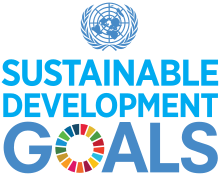| Sustainable Development Goals (SDGs) | |
|---|---|
 | |
| Mission statement | "A shared blueprint for peace and prosperity for people and the planet, now and into the future" |
| Location | Global |
| Founder | United Nations |
| Established | 2015 |
| Disestablished | 2030 |
| Website | www |
The 2030 Agenda for Sustainable Development, adopted by all United Nations members in 2015, created 17 world Sustainable Development Goals (SDGs). The aim of these global goals is "peace and prosperity for people and the planet"[1][2] – while tackling climate change and working to preserve oceans and forests. The SDGs highlight the connections between the environmental, social and economic aspects of sustainable development. Sustainability is at the center of the SDGs, as the term sustainable development implies.
The short titles of the 17 SDGs are: No poverty (SDG 1), Zero hunger (SDG 2), Good health and well-being (SDG 3), Quality education (SDG 4), Gender equality (SDG 5), Clean water and sanitation (SDG 6), Affordable and clean energy (SDG 7), Decent work and economic growth (SDG 8), Industry, innovation and infrastructure (SDG 9), Reduced inequalities (SDG 10), Sustainable cities and communities (SDG 11), Responsible consumption and production (SDG 12), Climate action (SDG 13), Life below water (SDG 14), Life on land (SDG 15), Peace, justice, and strong institutions (SDG 16), and Partnerships for the goals (SDG 17).
These goals are ambitious, and the reports and outcomes to date indicate a challenging path. Most, if not all, of the goals are unlikely to be met by 2030. Rising inequalities, climate change, and biodiversity loss are topics of concerns threatening progress. The COVID-19 pandemic in 2020 to 2023 made these challenges worse. The pandemic impacted all 17 goals and emphasized the interconnectedness of global health, economic, social, and environmental challenges.[3] Some regions, such as Asia, have experienced significant setbacks during that time. The global effort for the SDGs calls for prioritizing environmental sustainability, understanding the indivisible nature of the goals, and seeking synergies across sectors.
With regards to the political impact of the SDGs, it has been observed that they have mainly influenced global and national debates. By doing so, they have led to discursive effects for global and national debates. However, they have struggled to achieve transformative changes in policy and institutional structures.[3] The uneven prioritization of goals reflects longstanding national development policies. This complicates the global endeavor towards sustainable development. For example, there has long been a tendency to favor socio-economic objectives over environmental ones.[3]
Funding remains a critical issue for achieving the SDGs. Significant financial resources would be required worldwide. The UN, other international organizations, and national governments are trying to assist with funding efforts. Furthermore, the role of private investment and a shift towards sustainable financing are also essential for realizing the SDGs. Examples of progress from some countries demonstrate that achieving sustainable development through concerted global action is possible.
- ^ "The 17 Goals". Sustainable Development Goals. UN. Retrieved 10 August 2022.
- ^ United Nations (2017) Resolution adopted by the General Assembly on 6 July 2017, Work of the Statistical Commission pertaining to the 2030 Agenda for Sustainable Development (A/RES/71/313 Archived 28 November 2020 at the Wayback Machine)
- ^ a b c Cite error: The named reference
Biermann-2022was invoked but never defined (see the help page).